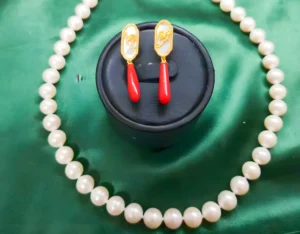
Create Your Royal Wedding Look with Chinese Royal Jewelry
Elevate your wedding look with Chinese royal jewelry.
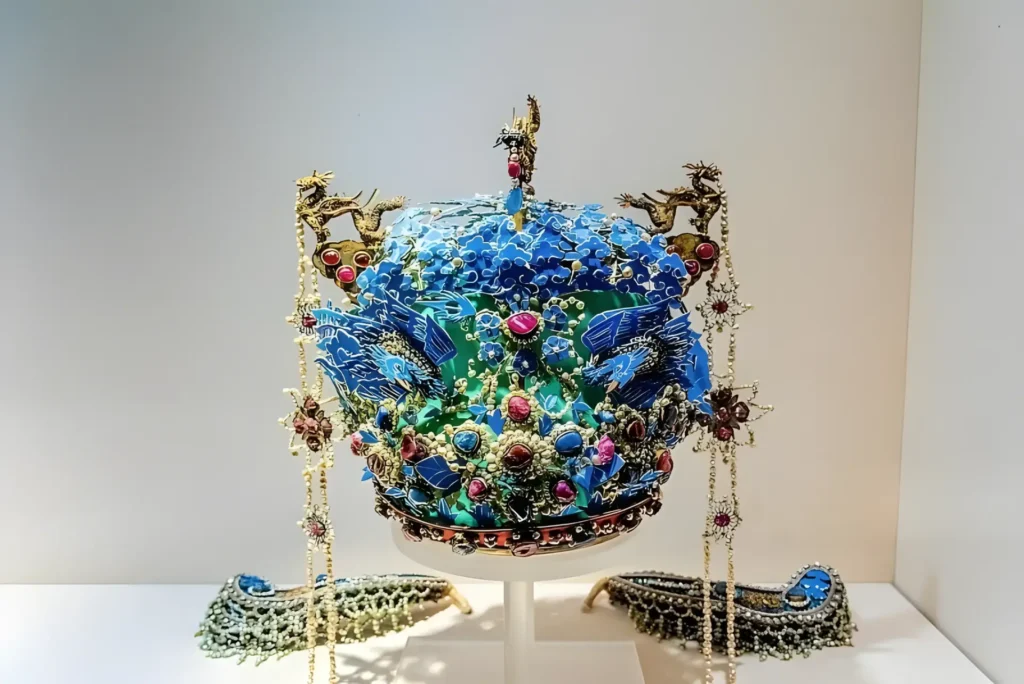
Unveiling the rich legacy of Chinese jewelry history offers an in-depth exploration of the intricate and symbolically rich adornments worn by Chinese royalty across various dynasties.
This article delves into the historical context, material and symbolism, cultural and social Impact, and modern influence through the imperial period, highlighting its role in symbolizing power, status, and religious beliefs.
Jewelry has always held a special place in Chinese culture, serving as a symbol of power, status, and artistic expression.
In ancient China it not only served as personal adornment but also played a critical role in political and religious rituals, reflecting the hierarchical structure of society.
From the earliest dynasties to modern times, Chinese royal jewelry has evolved in design and craftsmanship, reflecting the changing tastes and influences of different eras.
The Shang Dynasty (c. 1600 – 1046 BCE) marks the beginning of sophisticated jewelry-making in China, characterized by the use of materials like bronze, ceramics, stone, and bone, which were intricately crafted to reflect the hierarchical nature of society. This period set the stage for the evolution of royal jewelry, which was further developed by the Zhou Dynasty (1046 to 256 BCE). Craftsmen in Zhou Dynasty incorporated materials such as jade and bronze into royal jewelry, making it highly valued for its beauty and protection.
The medieval period saw significant transformations in Chinese royal jewelry, influenced by dynastic changes and extensive cultural exchanges via trade routes like the Silk Road. The Han Dynasty (206 BCE-220 CE) heralded a golden age for Chinese jewelry for introducing new materials such as silver and various gemstones such as turquoise and agate. The Tang Dynasty (618–907CE), often regarded as an age of flourish of artistry, introduced novel techniques and diverse materials, leading to the creation of vibrant and intricate jewelry pieces. The Song Dynasty (960–1279), however, embraced a more restrained elegance guided by Neo-Confucian philosophies that emphasized simplicity and traditionalism.
In the late imperial period, the Ming (1368–1644) and Qing (1644–1912) dynasties witnessed the evolution of royal jewelry styles that reflected significant cultural and political shifts. The Ming Dynasty saw jewelry becoming essential markers of status and identity, influenced by imperial dress reforms and sumptuary laws, while the Qing Dynasty introduced unique styles like the elaborate liangbatou headdresses.
The cultural and social impact of Chinese royal jewelry continues to be celebrated in various global exhibitions, highlighting its historical richness and artistic mastery.
In Ancient China, jewelry not only served as personal adornment but also played a significant role in symbolizing status and power. The archaeological findings from various Chinese dynasties offer a glimpse into the rich heritage and intricate craftsmanship of Chinese royal jewelry.
The origins of Chinese royal jewelry can be traced back to the Shang Dynasty .
Jewelry in Shang Dynasty was relatively simple, small and even plain, in form and craftsmanship.
Craftsmen of the Shang Dynasty had made good use of the hammering process. They hammered the gold into gold leaf, foil, or flakes for decorative artifacts. They also handcrafted a variety of gold ornaments such as the unique gold mask.
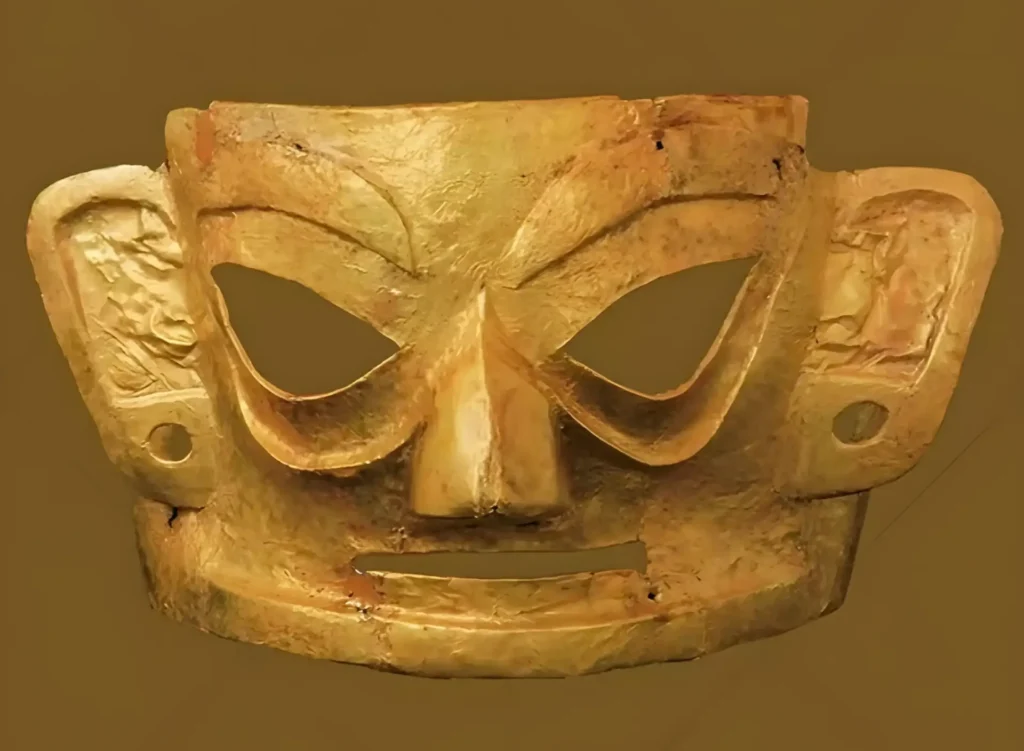
However, ethnic minorities, especially the Xiongnu in the north, developed more advanced production processes for gold and silver jewelry than those in the central and southern regions. You can see the fine craftsmanship of the time from the gold crown shown.
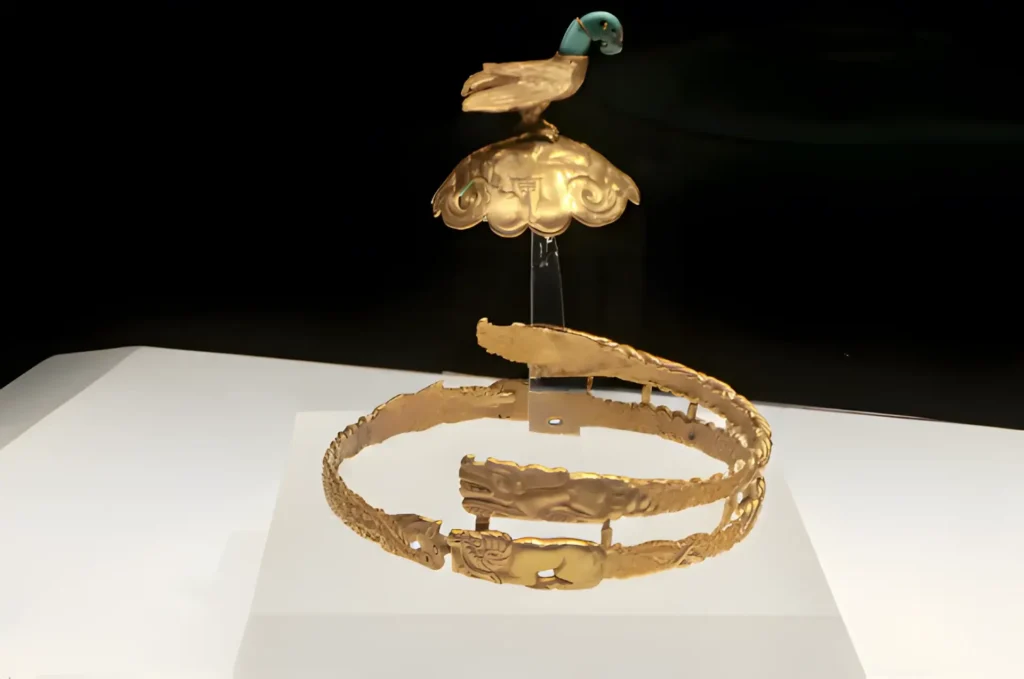
The northern Xiongnu had an amazing amount of gold and silver jewelry, using hammering, filigree, weaving, inlaying, and almost every kind of fine gold work.
The Zhou dynasty, spanning over eight centuries, witnessed the evolution of jewelry as symbols of feudal and royal authority. During the Xi (Western) Zhou (1046–771 BCE), the Zhou court maintained control over the country through a network of feudal states. This period saw the use of jade and bronze in jewelry, both materials being significant in Chinese culture for their beauty and supposed protective qualities.Fig. 1- shows a piece of jade in the shape of a dragon, which was used exclusively by the nobles of the time to emphasize their status and position.
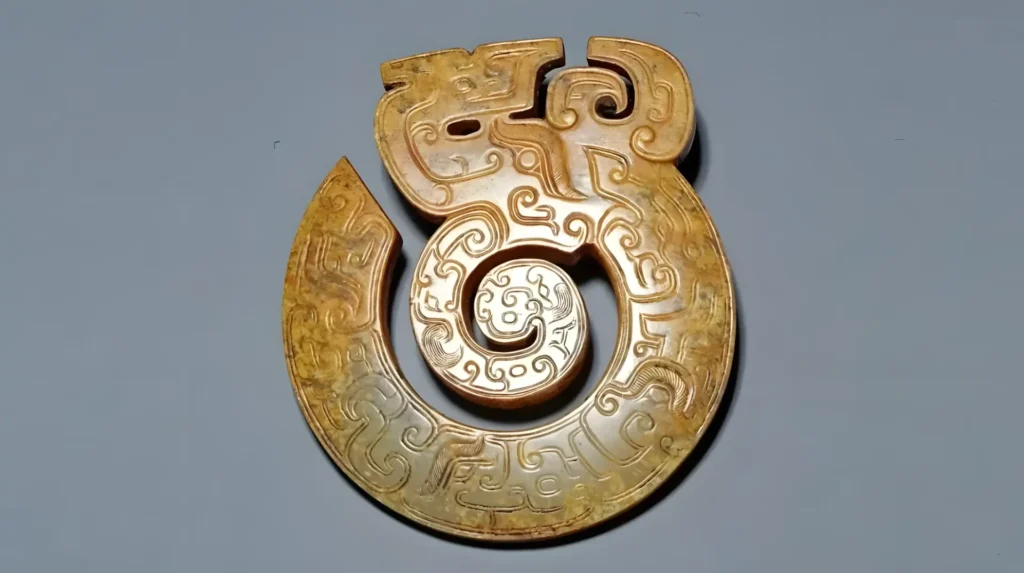
The breakdown of the feudal system in the Dong (Eastern) Zhou (770–256 BCE) led to the Chunqiu (Spring and Autumn) period (770–476 BCE) and the Zhanguo (Warring States) period (475–221 BCE), during which people had mastered the techniques of soldering, engraving, inlaying, gilding, hollowing, lost wax casting, and gold and silver mise-en-scène. On the basis of inheriting the shape and decoration of Western Zhou jade, Spring and Autumn jade wares showed various innovations.
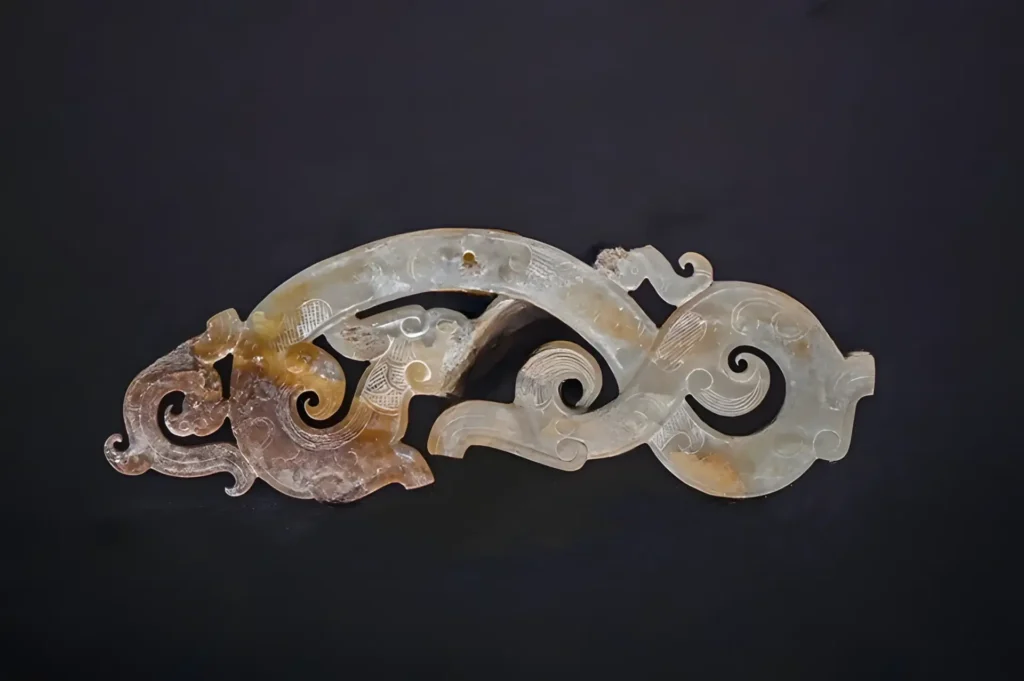
The worship of royal ancestors was central to the Zhou dynasty’s maintenance of political and religious hierarchy. Royal jewelry often played a role in these rituals, symbolizing the wearer’s connection to ancestral power and divine favor. The fixed schedule of ancestral cults, particularly after the reforms of Zujia, included the use of jewelry during rituals dedicated to royal ancestors. This connection between jewelry and ritualistic practices highlights the profound cultural significance of adornment in ancient China.
During the medieval period, Chinese royal jewelry saw significant evolution, influenced by various dynastic changes and cultural exchanges.
The Han Dynasty(206 BCE-220 CE), regarded as a golden age of Chinese civilization, played a pivotal role in shaping the aesthetics and intricacies of royal adornments.
The Han Dynasty heralded a golden age for Chinese jewelry, influenced significantly by the Silk Road trade routes. This era saw the introduction of new materials such as silver and various gemstones, including turquoise and agate. The craft of making gold and silver jewelry developed and matured. It eventually broke away from the traditional craftsmanship of the bronze craft into the independent development. The influx of these materials led to more diverse and luxurious jewelry designs.
The design of the Han Dynasty jewelry shows a fresh and indifferent simple beauty. As shown in Figure, the rectangular gold plate with two deer facing each other, each with a bird standing behind it, is full of serenity and harmony.
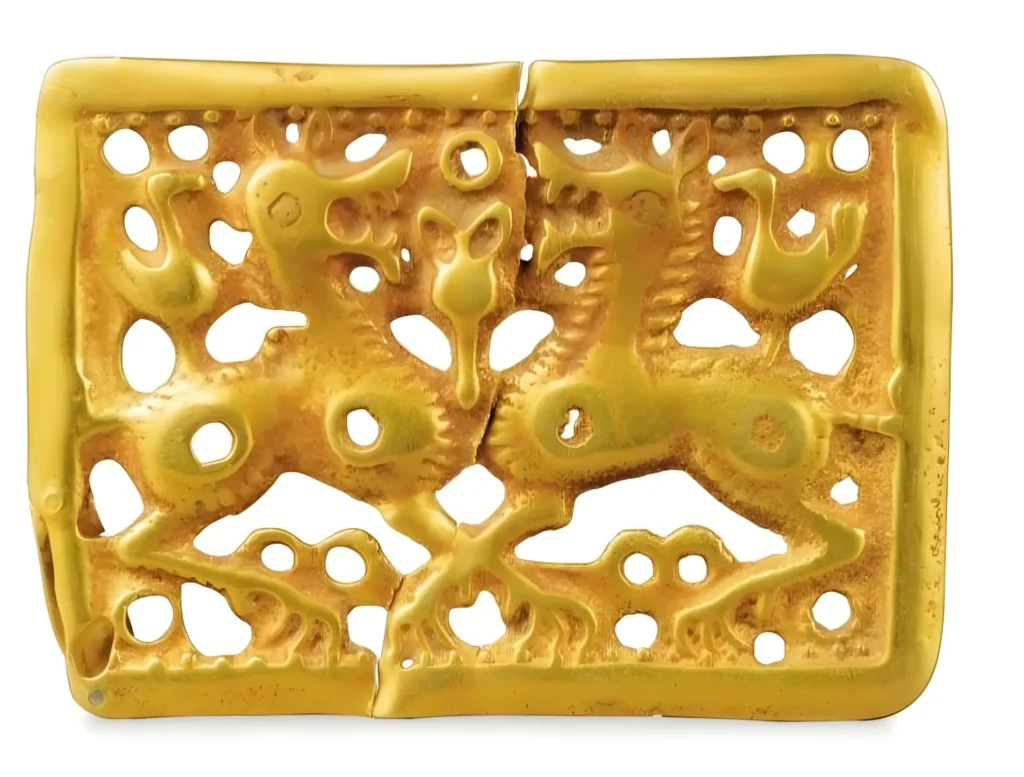
In the Han Dynasty also appeared for the first time a type of head ornament called “step rocker” that was inserted just beneath a hair bun, with gold and pearls dangling from it as one walked. It’s a kind of ritual jewelry for the Han Dynasty court consort, and later becomes popular for several dynasties.
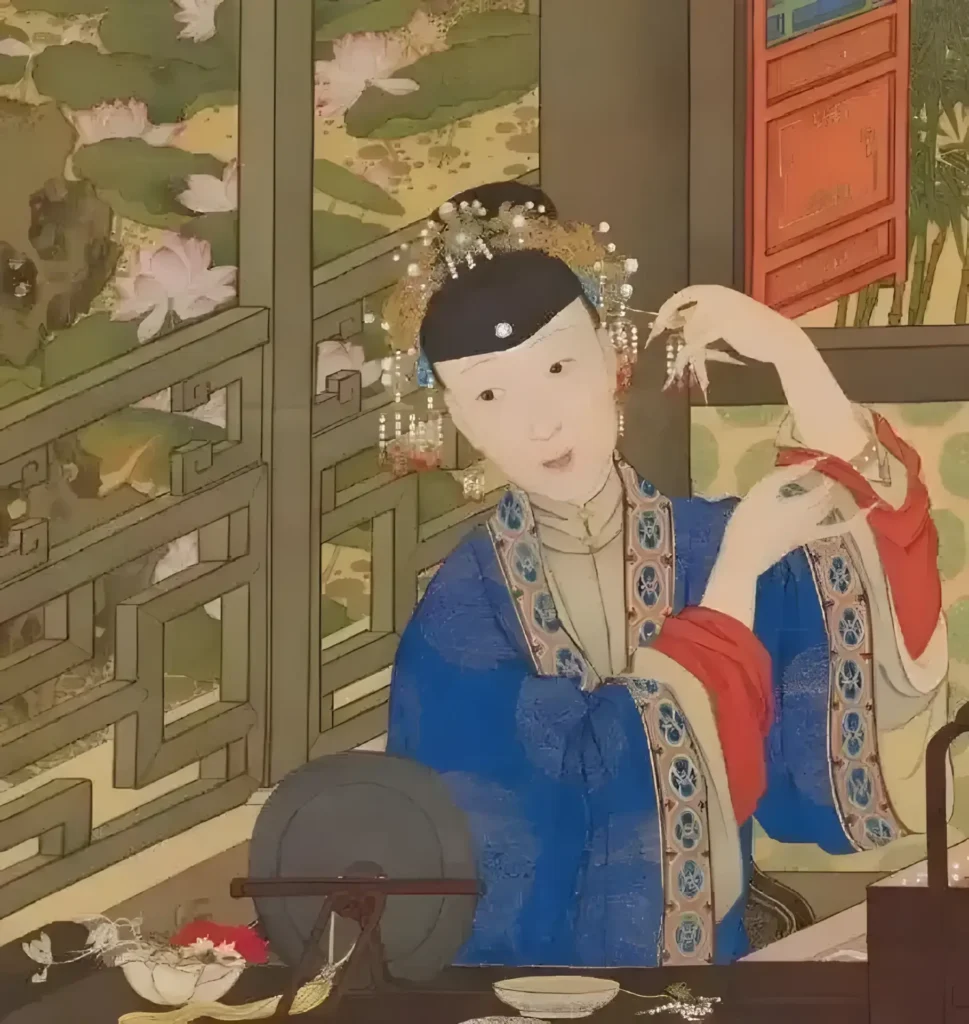
Another jewelry in the Han Dynasty is a kind of earring named as “Ear Danno”. It’s in the shape of a waist drum with one thicker end often raised in a hemispherical shape. And, it’s made of metal, jade and glass.
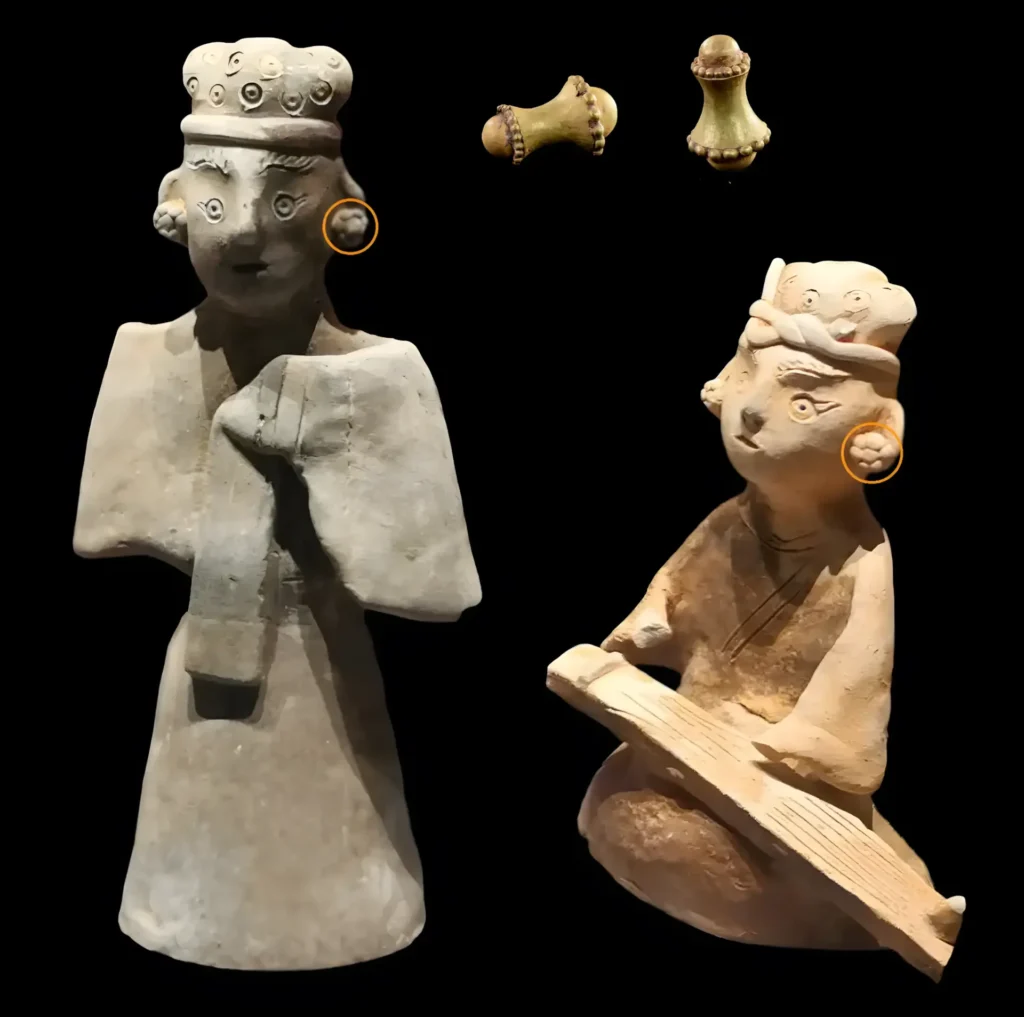
The Tang Dynasty is often regarded as a period of artistic flourishing in Chinese history. It was marked by a strong, cosmopolitan culture facilitated by extensive trade routes, both overland and maritime, such as the Silk Road. This exchange brought new technologies, cultural practices, and luxury items from Europe, the Middle East, Central and South Asia into China.Therefore, the art of gold and silver formed its skillful production techniques and the artistic characteristics of delicacy, elegancw and nobility.
Jewelry production technology in Tang dynasty is extremely complex and fine. Hammering, casting, welding, cutting, polishing, plating, burin, hollowing and other crafts were widely used to make a perfect match of gold, silver, pearls, gemstones. The colorful, rich and delicate style of jewelry is fully demonstrated, while the characteristics of different materials are brought into play.
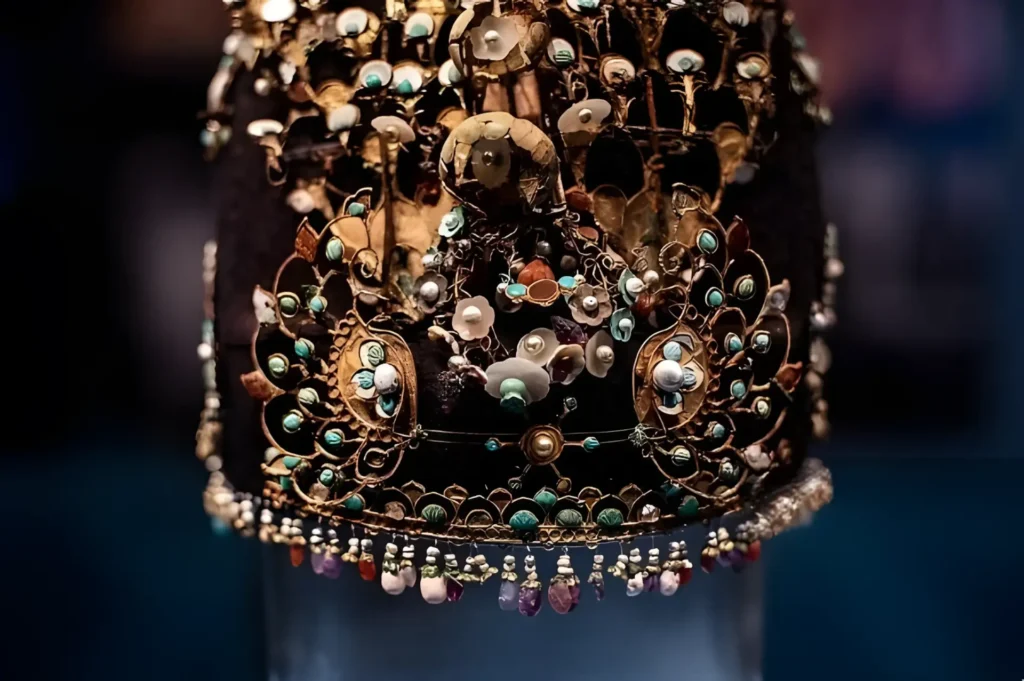
Technological advancements in metalworking and enameling allowed for more elaborate and colorful jewelry designs.Cloisonné became particularly popular during this time. It’s an ancient technique for decorating metalwork objects with colored material held in place or separated by metal strips or wire, normally of gold.
The jewelry style of the Tang Dynasty is characterized by great freshness, magnificence and richness, and is rich in sentimentality. It’s free from the formal, calm, mysterious, majestic temperament and makes people feel free, lively, and friendly.
Tang Dynasty jewelry often featured motifs such as flowers, birds, and mythical animals. The use of vibrant colors and intricate patterns made these pieces highly desirable and reflective of the period’s prosperity and cultural richness.
Following the tradition, hairpin and step rocker were still the important types of hair ornaments for women in Tang Dynasty. But there were more styles and decorations, such as phoenixes, birds, and entwined flowers. Craftsmen in the era attached great importance to the flower decoration at the tops of the hairpin. They made the flower decorations bigger and bigger, almost as long as the hairpin strands. During the Tang Dynasty, step rocker was still quite popular among all levels of society , with the most popular among the dignitaries.

Following the Tang dynasty, the Song dynasty further refined the aesthetics of royal jewelry, although with a different philosophical underpinning.
Neo-Confucian philosophies, which emphasized simplicity and traditionalism, significantly influenced the attire and adornments of the era. Unlike the Tang dynasty’s more extravagant styles, Song dynasty jewelry and clothing exhibited more restrained elegance, guided by a revival of ancient customs and a return to more traditional styles. The Song dynasty’s appreciation for antiquity and ceremonial propriety is evident in the meticulous selection of ornaments for various occasions, as dictated by the Rites of Zhou. These ornaments were carefully graded and chosen to reflect the ceremonial significance of events, demonstrating a blend of artistry and adherence to classical rituals
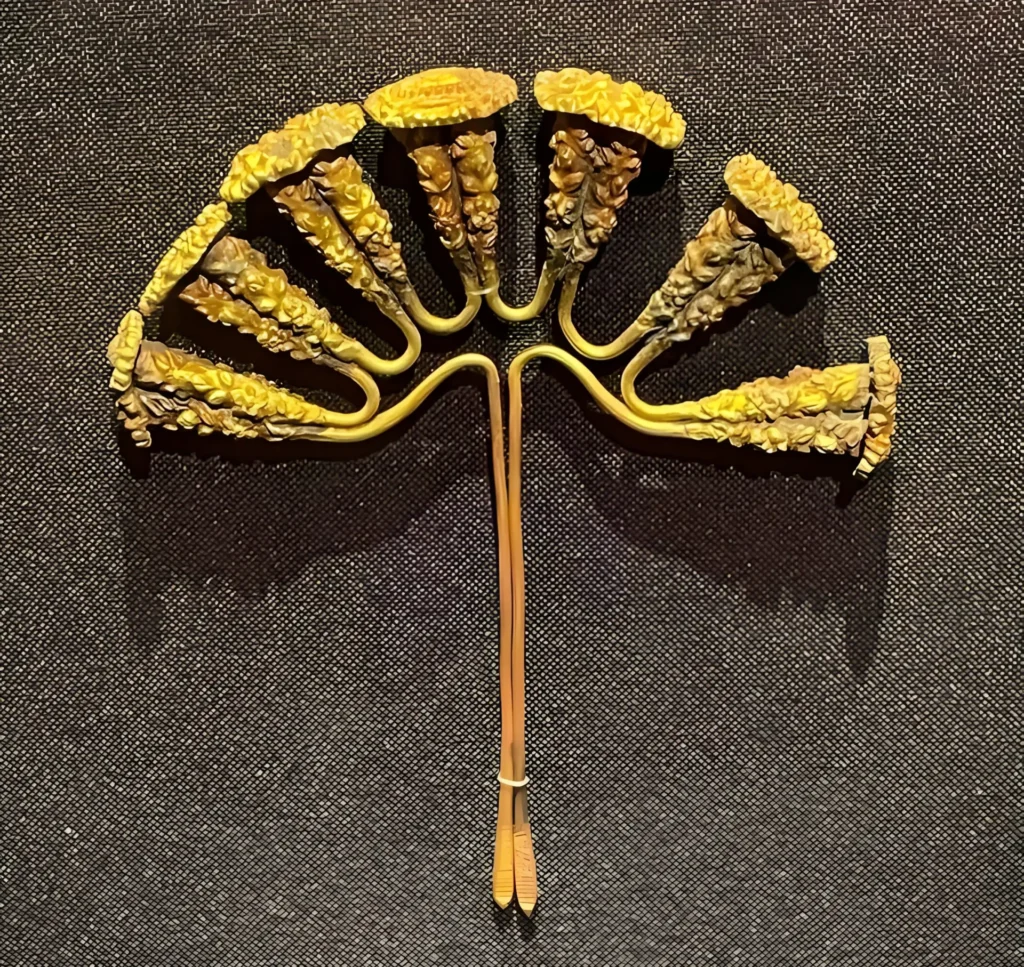
Innovations in craftsmanship during the Song Dynasty included more advanced metalworking techniques and the use of new materials. Jewelry from this period often featured delicate designs and understated elegance.
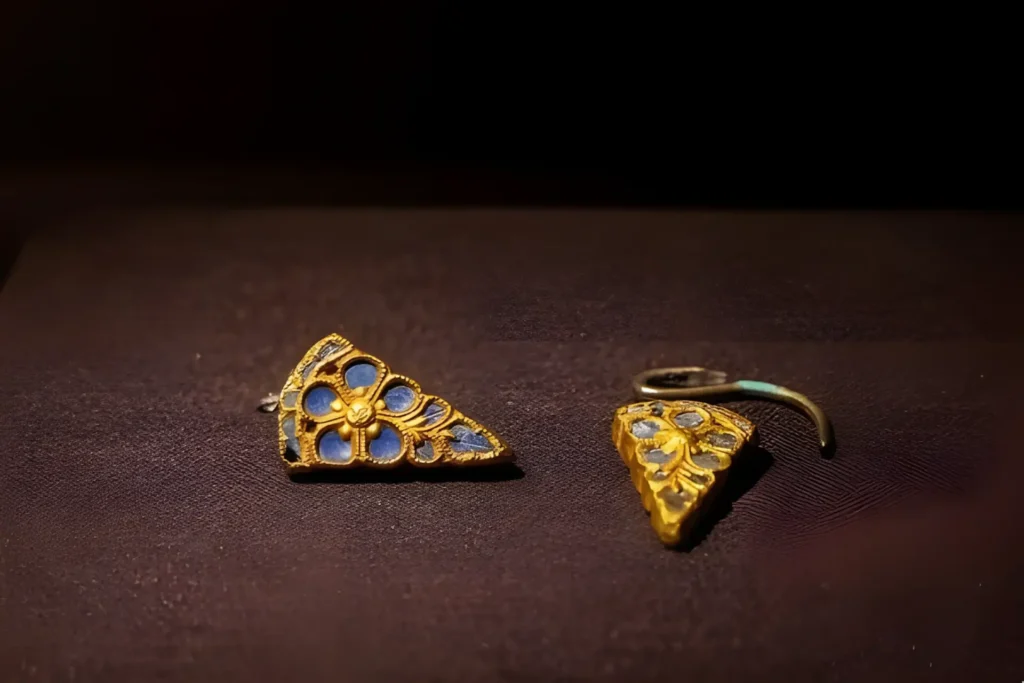
Throughout these periods, the continuous flow of goods and ideas along trade routes such as the Silk Road played a crucial role in the evolution of Chinese royal jewelry. The Tang dynasty’s extensive trade networks enabled the acquisition of new materials and techniques, which were then adapted to fit the Chinese aesthetic and cultural context. The subsequent Song dynasty maintained these trade connections, ensuring a steady influx of new influences while fostering a renewed focus on traditional values and simplicity in design. The evolution of Chinese royal jewelry during medieval times is thus a testament to the dynamic interplay between cultural exchange and philosophical shifts, each dynasty leaving its distinct mark on the art and craft of adornment.
During the Late Imperial period, Chinese royal jewelry reflected significant cultural and political changes that influenced the fashion and aesthetics of the time. The Ming Dynasty (1368–1644) and the Qing Dynasty (1644–1912) were notable eras in which jewelry styles evolved distinctively.
The Ming Dynasty saw a revival of traditional techniques such as cloisonné and filigree. These methods were used to create highly detailed and ornate jewelry pieces that reflected the grandeur and opulence of the imperial court.
In order to achieve more perfect artistic effects craftsmen in Ming Dynasty seldom used a single process to make jewelry, often using two or more than two processes, . The workmanship is mainly based on filigree work, and is sometimes accompanied by hammering, weaving, pinching, hollowing, welding, casting and other techniques. The jewelry is finely crafted, opulent and antique, with a strong courtly flavor.
For example, when a gold hairpin is made, a gold holder made of very fine gold wires is usually soldered to its top and a variety of colored gemstones are inlaid inside the holder, complementing each other in a luxurious way.
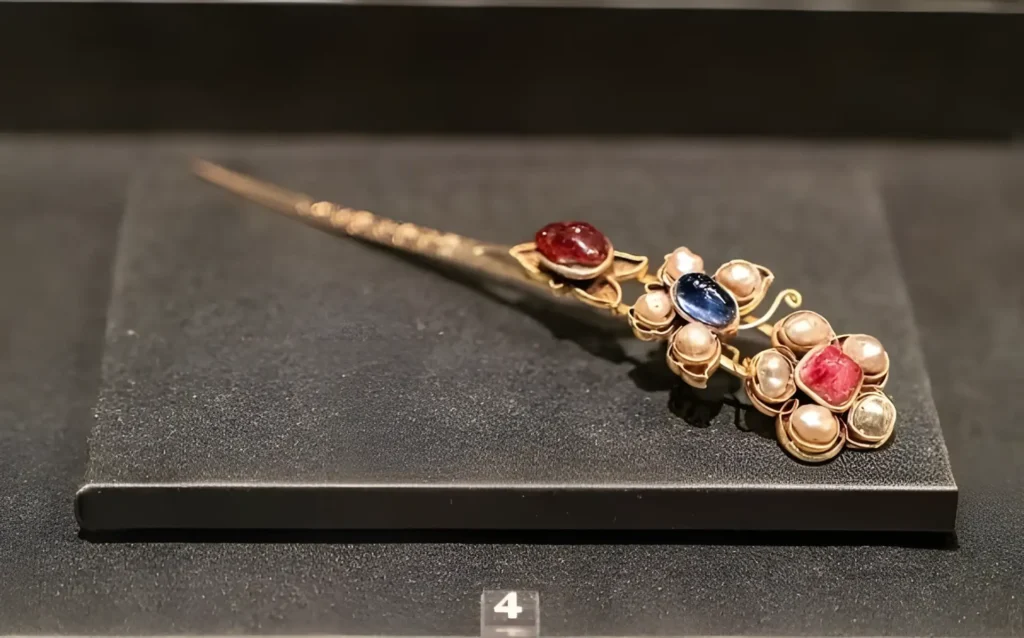
In the Ming Dynasty, jewelry became an essential marker of status and identity. Imperial power influenced dress reforms and sumptuary laws, which regulated the types of jewelry that different classes could wear. Emperors utilized jewelry as a symbol of their authority, and skilled artisans were employed to create exquisite pieces exclusively for the royal family. They often used materials such as gold, silver, and jade, and decorated them with pearls and precious stones.

The style of Ming jewelry is characterized by solemnity and generosity, and the motifs are both inherited and developed from previous generations, resulting in a rich variety of themes. The patterns imitating plants and animals increase significantly compared to the previous generations. Among them, the plants are mostly in the shape of flowers and leaves.
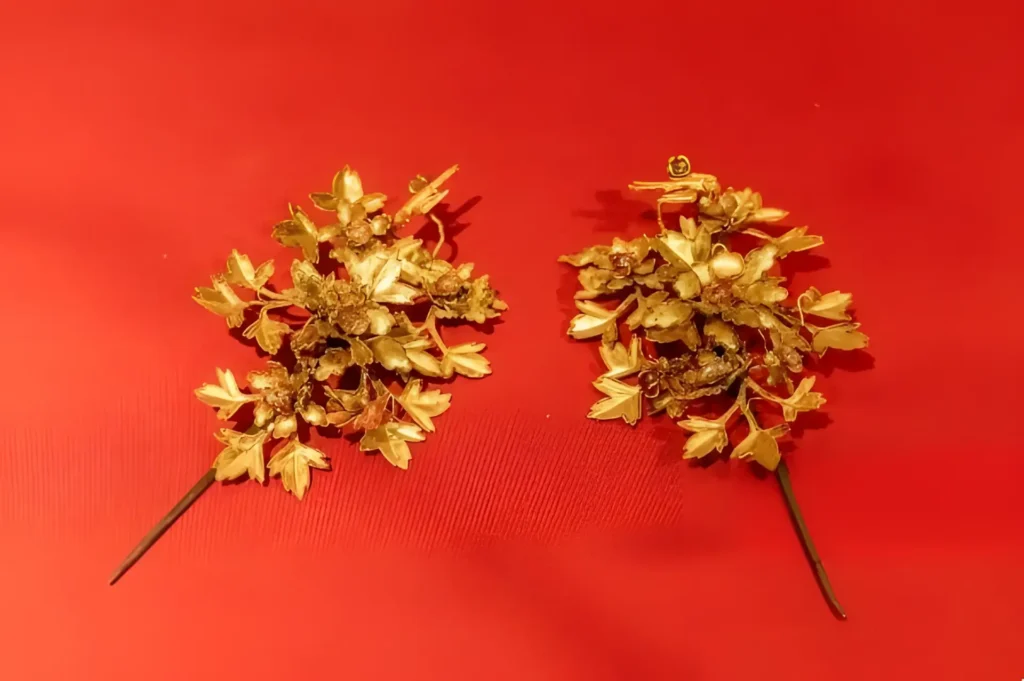
Famous pieces of jewelry from the Ming Dynasty include elaborate hairpins, brooches, and necklaces adorned with intricate designs and precious gemstones. These items were often passed down through generations as treasured heirlooms.
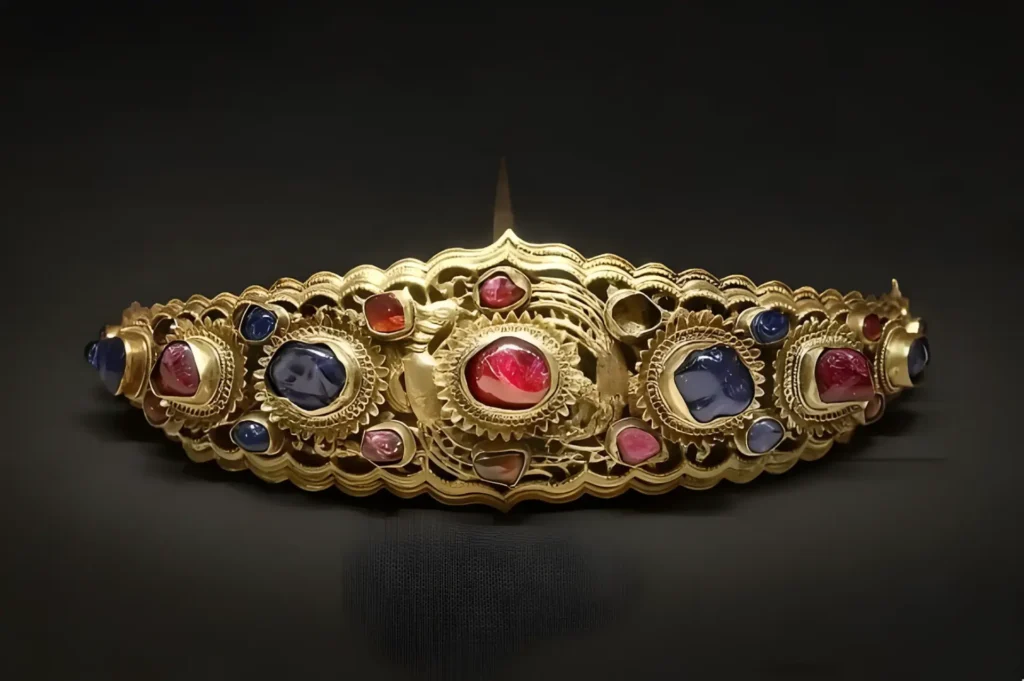
The Qing Dynasty represented the pinnacle of Chinese jewelry craftsmanship. This period saw the integration of Manchu and Han styles, resulting in unique and diverse designs.
The Manchu rulers brought their own unique styles, which included the use of large earrings and elaborate headdresses known as liangbatou. These headdresses were often decorated with kingfisher feathers, coral, and jade, showcasing the exquisite craftsmanship of Qing artisans.
Meanwhile, the Qing Dynasty saw a heightened emphasis on the preservation of traditional Chinese elements in jewelry design, even as Western influences began to trickle into China. This period marked a balance between innovation and tradition, ensuring that the essence of Chinese cultural heritage was maintained.
The Qing Dynasty also saw the influence of European designs and techniques. This cross-cultural exchange led to the creation of jewelry that combined traditional Chinese motifs with Western aesthetics, resulting in a distinctive and innovative style.
Qing Dynasty jewelry was not only about personal adornment but also played a significant role in court ceremonies and rituals. The use of jade was particularly prominent, as it was considered a stone of immortality and a symbol of moral integrity. The emperor and empress would wear jade accessories during important state functions to reflect their virtuous rule.
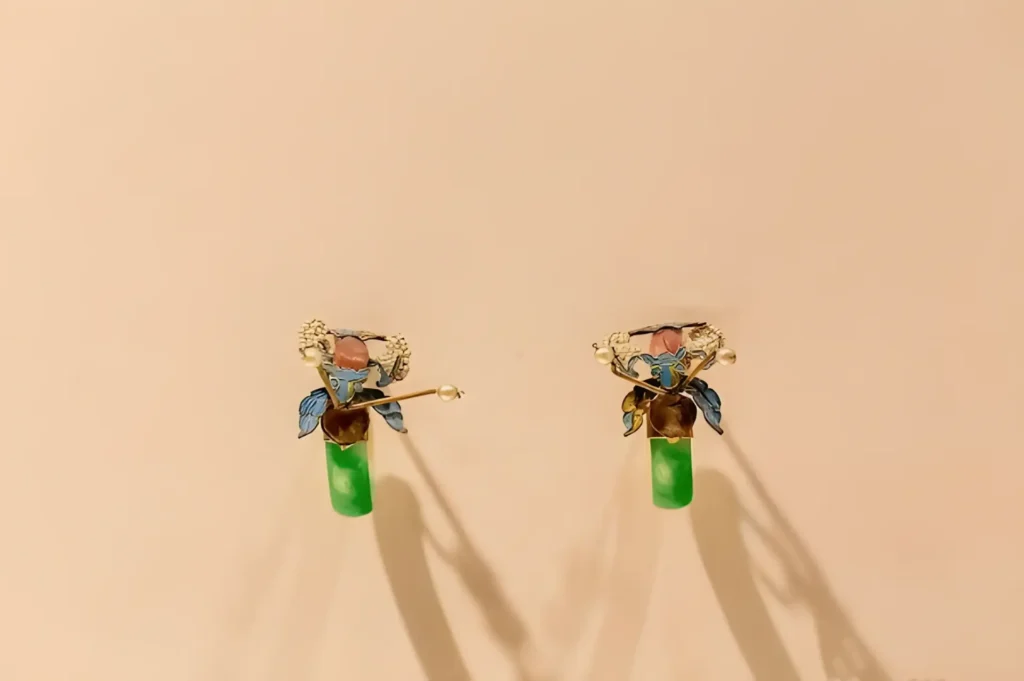
For instance, one of the most recognizable traditional Chinese jewelry items is the jade bangle, symbolizing protection, good fortune, and long-lasting love. Jade’s natural beauty and toughness make it the perfect embodiment of these wishes.
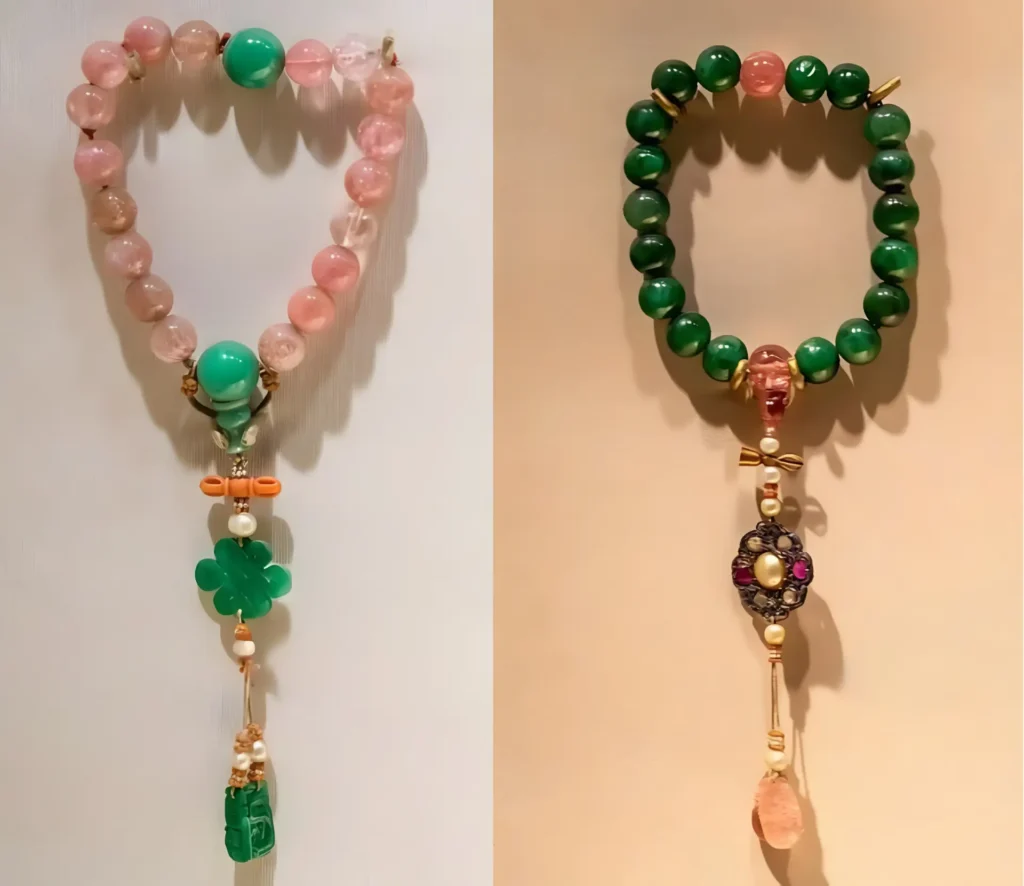
In terms of jewelry craftsmanship, the production level of the Qing Dynasty far exceeded those of other dynasties, and the techniques were developed by leaps and bounds.
The craft of jewelry making in the Qing Dynasty includes casting, hammering, soldering, filigree, inlaying, etc., and synthesizes a variety of techniques, such as yin line, yang line, and hollowing.
In addition, new technology “Kingfisher feather art” appeared. Jewelry artisans cut the kingfisher’s feathers according to the design and attach them to the gold and silver jewelry according to the requirements of flatness, proportionality and base coverage.
As the phoenix hairpin shown in Figure 1-12, it applies the technology “Kingfisher feather art” to its feathers, in addition to the use of other techniques like inlaying and soldering etc., making the hairpin vivid.
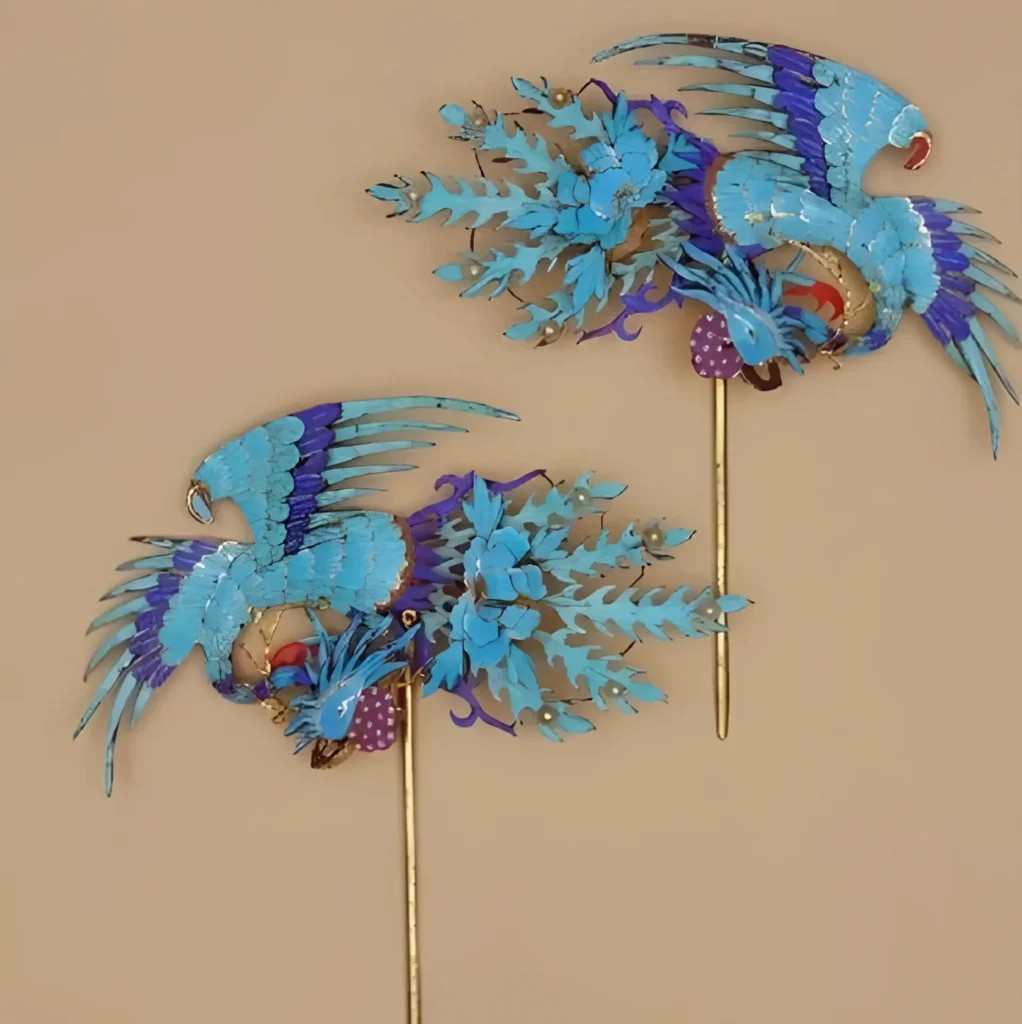
The Dynasties in the Late Imperial China saw the influence of European designs and techniques. This cross-cultural exchange led to the creation of jewelry that combined traditional Chinese motifs with Western aesthetics, resulting in a distinctive and innovative style.
In the above historical process of Chinese royal jewelry, “materials” and “symbols” played a crucial role in imperial ceremonies, rituals and daily adornments, embodying cultural significance. Here is the brief on them.
Jade has always been a cornerstone of Chinese jewelry. Its cultural significance and variety, ranging from translucent white jade to deep green jadeite, have made it a cherished material throughout Chinese history.
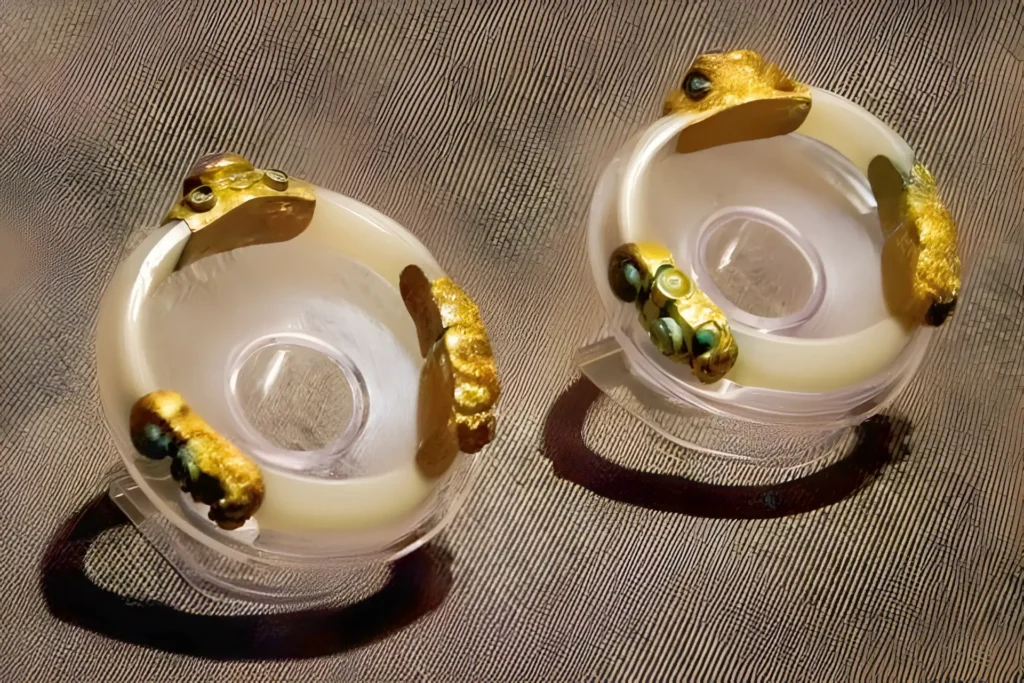
Gold and silver have been used extensively in Chinese royal jewelry for their symbolic meanings of wealth and purity. These metals were often intricately worked into delicate designs, reflecting the high level of craftsmanship.
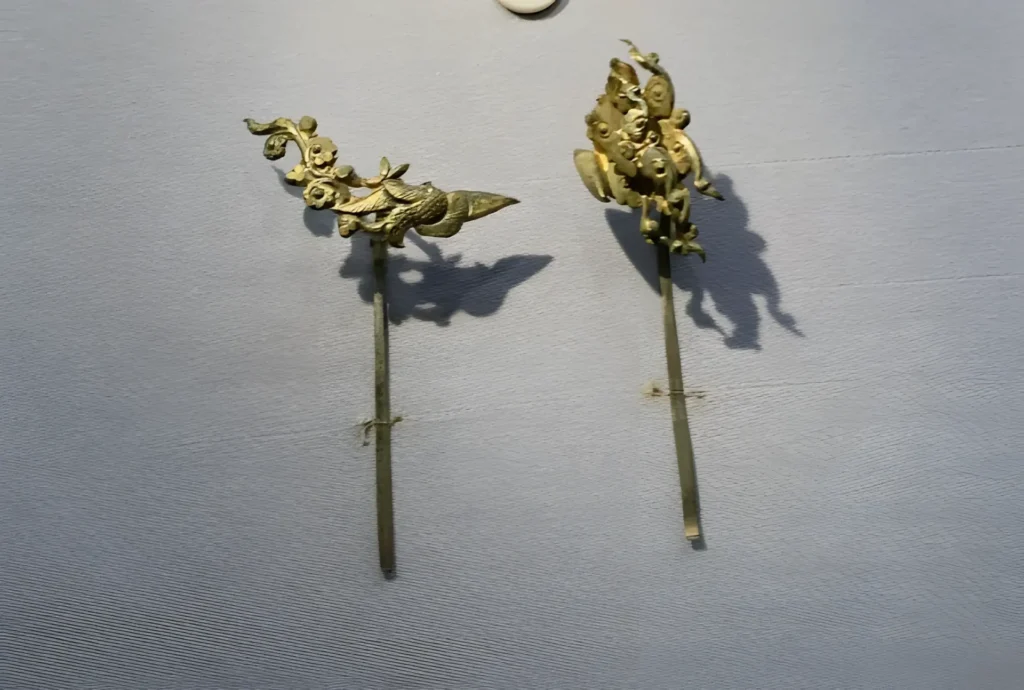
Cloisonné enamel, with its vibrant colors and intricate designs, is a hallmark of Chinese jewelry. The process involves creating small compartments on metal surfaces filled with enamel paste, which is then fired to create a smooth, glossy finish.
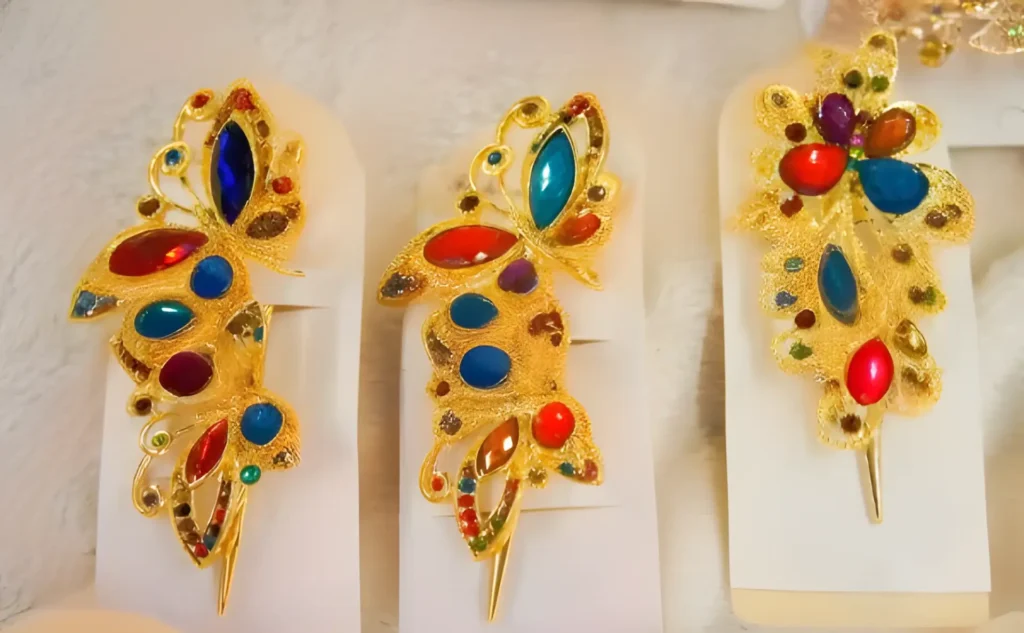
Various gemstones and pearls have been used in Chinese royal jewelry, each carrying its own significance. Turquoise, agate, and coral were popular choices, often set in elaborate designs to enhance their natural beauty.
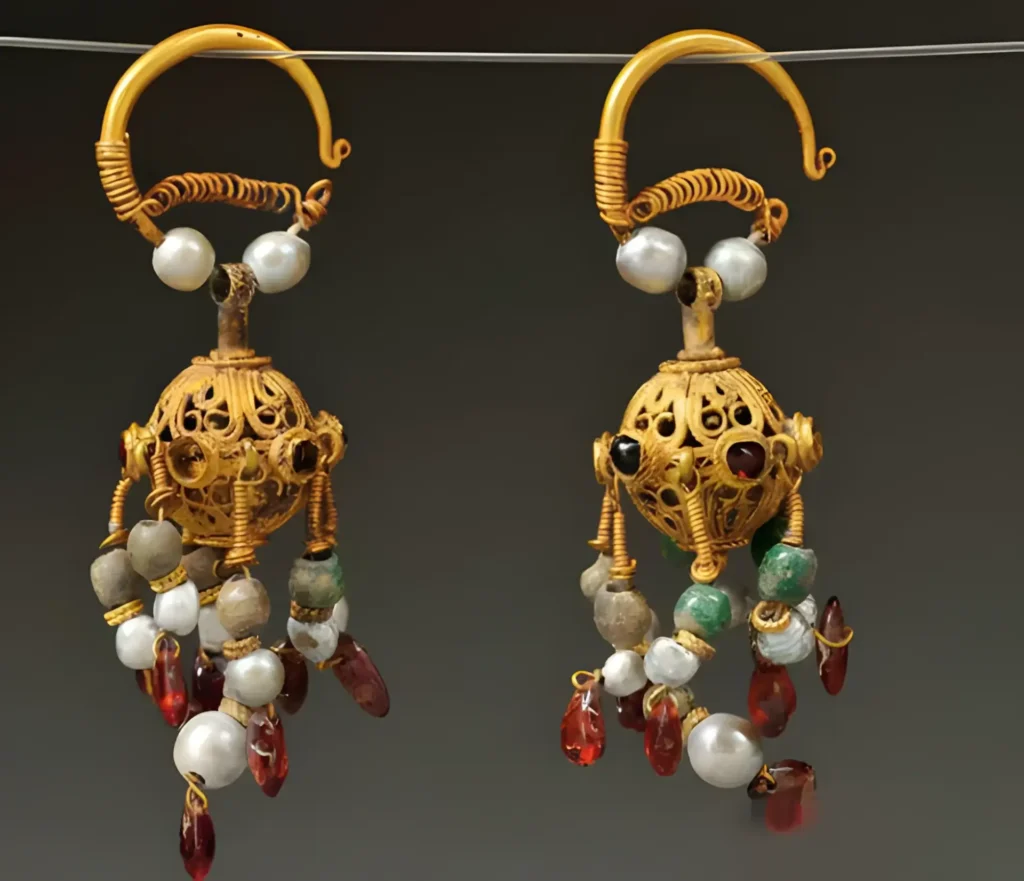
Explore the history, symbolism, evolution, and modern trends of Chinese jewelry, including craftsmanship in jade, gold, silver, and pearls.
Read NowMotifs such as dragons, phoenixes, and lotus flowers are commonly found in Chinese royal jewelry. These symbols carry deep cultural meanings, representing power, rebirth, and purity respectively.
Colors also play a significant role in the symbolism of Chinese jewelry. Red represents good fortune and joy, while gold symbolizes wealth and power. Each color used in jewelry carries its own unique significance, adding another layer of meaning to these exquisite pieces.
Discover the historical significance and modern symbolism of Chinese jewelry. Learn about common symbols and their meanings in our comprehensive guide.
Read NowLooking back at the Chinese jewelry history, we can see the cultural and social Impact embodied in the use of jewelry.
The evolution of Chinese royal jewelry has had profound cultural and social impacts throughout Chinese history. The elaborate ornamentation used by emperors, councilors, dukes, princes, ministers, and officials not only served as a display of wealth and power but also played a crucial role in the Confucian rituals that underpinned the social hierarchy.
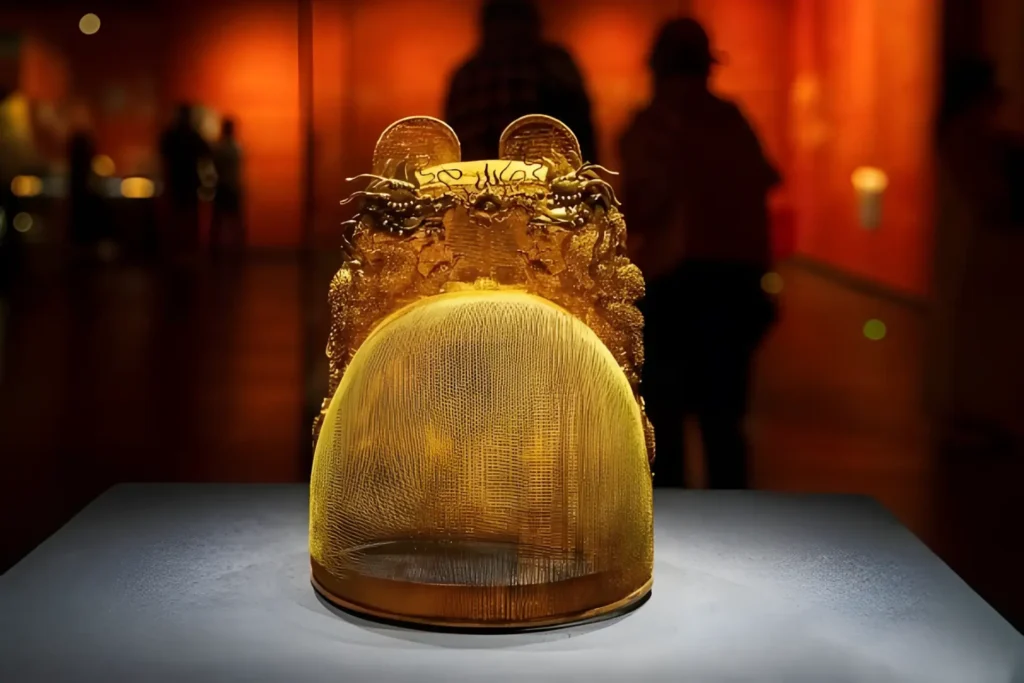
Regulations specified the use of distinct styles of clothing and jewelry based on social ranks, and this differentiation extended to headgear, fabric materials, and ribbons attached to officials’ seals. These ribbons, placed in leather pouches at the wearers’ waists, varied in color, size, and texture to indicate rank, reinforcing the structured social order. During the Ming Dynasty, the influence of such jewelry and ornamentation was seen not just within the royal court but also in theatrical costumes, which drew inspiration from these historical styles.Theatrical productions utilized these elements to convey character ranks and roles, mirroring the social stratification of the.
The practice of burying elaborate jewelry with the dead, a tradition that began in the Bronze Age and continued through various dynasties, underscores the importance of these items in both life and death. For instance, ritual bronzes, often elaborately decorated, were placed in tombs to ensure the deceased could continue their ritual practices in the afterlife, indicating the profound belief in an afterlife where social status was maintained. Furthermore, the ritual significance of jewelry and ornamentation extended to other cultural practices such as human sacrifice and the use of clay figures as substitutes for humans in tombs. From the Zhou dynasty onwards, these clay figures were adorned with items that symbolized the deceased’s social status, which included various types of jewelry. The Terracotta Army, for example, is a famous manifestation of this practice, where the soldiers and attendants in Emperor Qin Shihuang’s tomb were equipped with weapons and armors that reflected their roles and ranks in life.
By the Tang Dynasty, specific types of jewelry such as tin hairpins used by noblewomen became integral to ceremonial attire. These items were not merely decorative but held significant cultural importance, as noblewomen were required to wear them during formal banquets and ceremonial meetings. The excavation of a small tomb in Xi’an revealed that such customs were rigorously followed, as seen in the tomb of a daughter of the Li Tang clan, where her burial items reflected her noble status and adherence to ritualistic norms.

These cultural practices underscore the interplay between social structure, ritual, and material culture in ancient China, where jewelry and ornamentation were not just personal adornments but powerful symbols of identity and social order.
Modern designers continue to draw inspiration from the rich history of Chinese royal jewelry. By blending traditional motifs with contemporary styles, they create pieces that pay homage to the past while appealing to modern tastes. This fusion of old and new keeps the legacy of Chinese royal jewelry alive in today’s fashion world.
The influence of Chinese royal jewelry extends to current fashion trends. Elements such as intricate metalwork, vibrant enameling, and the use of symbolic motifs are increasingly seen in contemporary jewelry designs. This enduring appeal highlights the timeless beauty and cultural significance of Chinese royal jewelry.
The evolution of Chinese royal jewelry from ancient dynasties to modern times is a testament to the enduring artistry and cultural significance of these exquisite pieces. Each era brought new materials, techniques, and designs, contributing to the rich tapestry of Chinese jewelry.

Today, the legacy of Chinese jewelry history continues to inspire and captivate, reflecting the timeless beauty and profound heritage of this ancient art form.
Why is jewelry so important in Chinese culture?
Jewelry in Chinese culture is not only an adornment but also a symbol of wealth, status, and spiritual beliefs. It plays a crucial role in rituals, celebrations, and even daily life, reflecting the deep cultural significance and values of Chinese society.
How did Chinese royal jewelry evolve over time?
Chinese royal jewelry evolved through various dynasties, each contributing unique styles and techniques. From the ritualistic adornments of the Shang and Zhou dynasties to the opulence of the Ming and Qing dynasties, royal jewelry reflects the changing tastes, political power, and cultural influences of each era.
What were the earliest forms of Chinese jewelry?
The earliest forms of Chinese jewelry date back to the Shang Dynasty, where jade, bone, and ivory were commonly used. These pieces often carried religious or ritualistic significance, with designs reflecting the beliefs and practices of ancient Chinese society.
How did rituals influence the design of Chinese jewelry?
Rituals played a significant role in shaping the design of Chinese jewelry, particularly during the Zhou Dynasty. Jewelry pieces were often created to serve as amulets or offerings, with specific symbols and materials chosen to convey spiritual meaning and ensure protection or blessings.
What characterizes jewelry from the Han Dynasty?
The Han Dynasty is considered a golden age for Chinese jewelry, characterized by intricate designs, the extensive use of gold and jade, and the introduction of new techniques like inlay work. Jewelry from this period reflects the prosperity and artistic advancements of the time.
How did trade and cultural exchange influence Chinese jewelry design?
Trade and cultural exchange, particularly along the Silk Road, introduced new materials, techniques, and designs to Chinese jewelry. This interaction with other cultures led to a fusion of styles and the incorporation of foreign elements into traditional Chinese jewelry.
What was the impact of Western influence on Chinese jewelry during the Qing Dynasty?
Western influence during the Qing Dynasty brought new styles, materials, and techniques to Chinese jewelry. This period saw the introduction of modern tools and methods, leading to more intricate designs and the blending of Eastern and Western aesthetics.
What materials were commonly used in traditional Chinese jewelry?
Traditional Chinese jewelry primarily used materials like jade, gold, silver, pearls, and various gemstones. Each material was chosen for its cultural significance, symbolic meaning, and perceived protective properties.
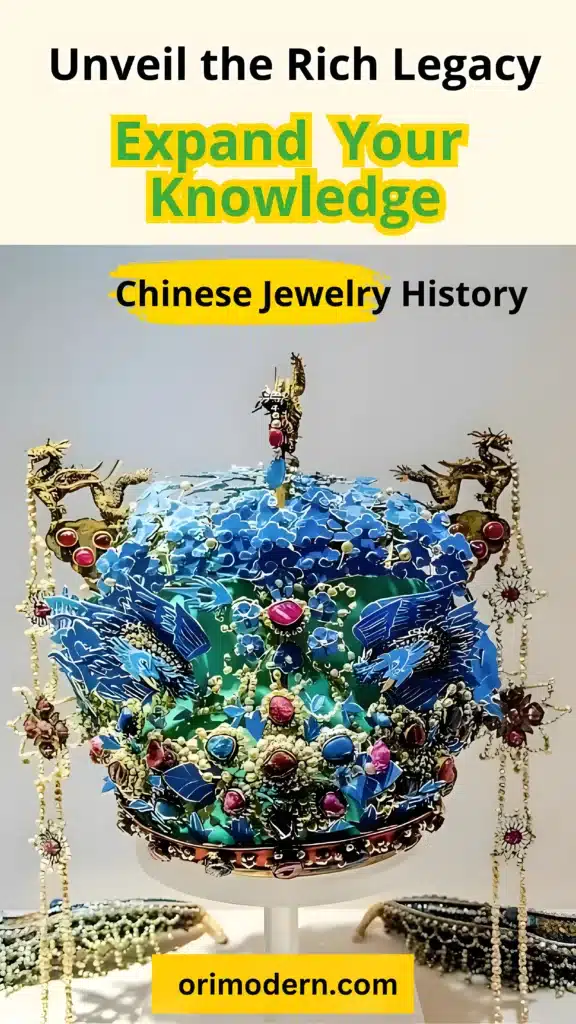


Elevate your wedding look with Chinese royal jewelry.
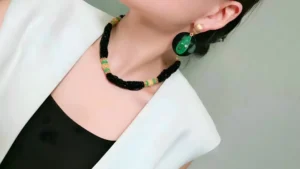
Learn to pair Chinese royal jewelry with your outfits for a stylish upgrade.
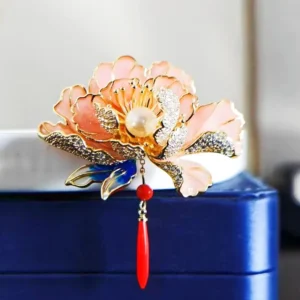
Explore the symbols in Chinese jewelry and their meanings to unlock their mysteries.